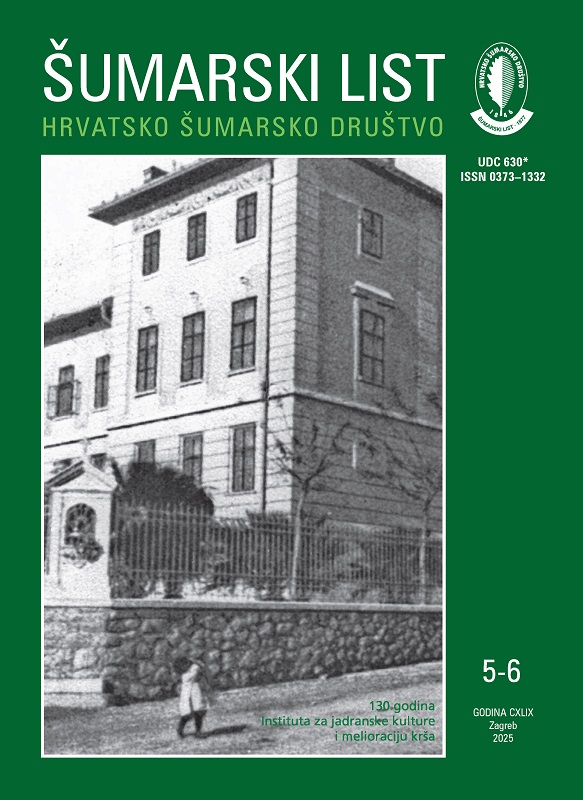| |
| RIJEČ UREDNIŠTVA |
| |
|
|
| Uredništvo HŠD | |
| Should we be surprised by the higher export of timber than furniture from Croatia?
pdf
HR
EN
|
217 |
| |
| IZVORNI ZNANSTVENI ČLANCI |
| |
|
|
| Tatjana Mandić Bulić, Marilena Idžojtić | UDKps://doi.org/10.31298/sl.149.5-6.1 |
| Woody plants of the Brijuni national park
pdf
HR
EN
|
219 |
| Esmera Kajtaz, Dženita Alibegić, Haris Nikšić, Željko Španjol, Boris Dorbić | UDKps://doi.org/10.31298/sl.149.5-6.2 |
| Determination of antioxidant profile of the essential oil and extract samples obtained from lavender (Lavandula angustifolia Miller)
pdf
HR
EN
|
233 |
| Ayşegül Tekeş, Serkan Özdemir, Candan Aykurt, Serkan Gülsoy, Kürşad Özkan | UDKps://doi.org/10.31298/sl.149.5-6.3 |
| Species distribution modeling of red hawthorn (Crataegus monogyna Jacq.) in response to climate change
pdf
HR
EN
|
243 |
| Ali Bayraktar, Deniz Güney, Fahrettin Atar, Ibrahim Turna | UDKps://doi.org/10.31298/sl.149.5-6.4 |
| Evaluation of rooting responses in Lagerstroemia indica L. cuttings under different greenhouse settings, rooting media, and phytohormonal applications
pdf
HR
EN
|
255 |
| Hediye Aktaş Aytepe, Ali Kavgaci | UDKps://doi.org/10.31298/sl.149.5-6.5 |
| Syntaxonomical contribution to the vegetation classification of Türkiye from SW Anatolia: a plant diversity hotspot
pdf
HR
EN
|
265 |
This study was carried out to determine the vegetation diversity and gradient of the Bencik Mountain in SW Anatolia, Türkiye, which is a plant biodiversity hotspot. The field sampling was realized in accordance with the Braun-Blanquet’s methodology. For the classification of communities, hierarchical cluster analysis was used. Ecological interpretation of the defined communities was done by nonmetric multi-dimensional scaling with passive projection of topographical variables. Five plant communities belonging to different vegetation types (forest, macchia and regressive successional stage) were identified. Except for regressive successional stage, the others were described at the association level. Three of them were newly described. The pine-dominated forests are represented by Hymenocarpo circinnati-Pinetum brutiae under the alliance Styraco officinalis-Pinion brutiae (Pinetalia halepensis, Pinatea halepensis) and Vicio lathyroidis-Pinetum pallasianae under the alliance Adenocarpo-Pinion pallasianae (Erico-Pinetalia, Erico-Pinetea). Both of them are new associations. The riparian sites are represented by Nerio oleandri-Platanetum orientalis under the alliance Platanion orientalis (Populetalia albae, Alno glutinosae-Populetea albae). The macchia is represented by Daphno gnidiois-Quercetum cocciferae, a new association belonging to the alliance Quercion cocciferae (Quercetalia cocciferae, Quercetea ilicis). The regressive successional stage is represented by the Aegilops triuncialis-Clypeola jonthlaspi community, which resulted from the overgrazing and intensive human use of Quercus coccifera macchia. Floristic differentiation of the study area vegetation is significantly correlated with topographical variables (elevation and aspect). This study not only indicated the diverse vegetation richness of the area and its nature conservation value but also made an important contribution to the understanding of Mediterranean vegetation in Türkiye.
|
| |
| PREGLEDNI ČLANCI |
| |
|
|
| Igor Anić | UDKps://doi.org/10.31298/sl.149.5-6.6 |
| History of pedunculate oak forest regeneration in Croatia
pdf
HR
EN
|
279 |



